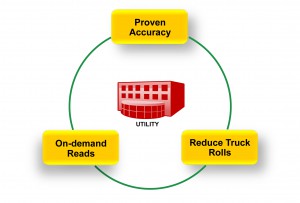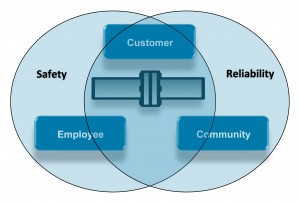July 2010 Vol. 237 No. 7
Features
Gas Advanced Metering Infrastructure Is A Market Primed For Innovation

Global natural gas reserves of over 6,000 Tcf would suggest abundant supplies to meet continuing increases in demand. Yet, like oil, it is a non-renewable resource. As society comprehends the inevitable decline of fossil fuels and the impacts of carbon dioxide emissions, energy utilities and consumers are realizing the significance of long-term energy sustainability and the expanding role of natural gas:
- As a storable energy, natural gas plays a vital part in the development of a smart grid.
- Low emissions make natural gas a clean fuel in a world concerned with carbon output.
- With an abundant supply, natural gas plays a central role in developing energy independence.
- Greater operational and delivery efficiencies help sustain the role of natural gas in a global energy future and reliable service to customers.
Due to its abundance, natural gas operators do not face the demand response hurdles that electrical operators confront. Rather, gas operators face fluctuating commodity availability and costs due to cyclical demands. In conjunction with long-term price uncertainty, gas utilities are up against operational and environmental constraints, along with an overburdened delivery infrastructure. In this evaluation, new business cases are identified in an effort to benefit gas utilities, as well as society:
- Reducing the number of utility vehicles on the road lowers operational and maintenance costs as it helps to moderate traffic congestion and lower carbon emissions.
- Empowering utility customers with up-to the minute gas usage information to actively engage them in their consumption decisions and subsequently lower their gas bills, in turn helping the utility to manage overall demand.
- Real-time gas distribution monitoring offers increased safety and reliability for the community, as well as utility workers, and lowers maintenance costs.
- Customers are afforded greater safety at home and utilities can avoid a truck roll by shutting off service remotely in case of a leak or safety event.
- Access to real-time customer usage information accelerates the resolution of bill inquiries to lower operational costs and instills greater confidence and satisfaction from customers.
Gas utilities are recognizing the importance of enhancing operational efficiencies, impacting consumer consumption behaviors, enabling conservation efforts and increasing distribution integrity, in addition to system safety. To achieve these goals, they are considering gas advanced metering infrastructure (gas AMI) as the answer.
AMI in the electric industry was initially associated with hyperbole, but several years later, vendors and electric utilities worked through the excitement and are now deploying AMI solutions that are truly transforming the operations of electric providers across the globe.
AMI is comparatively new to the gas industry, but it leverages the clarity and capabilities already achieved in the electric industry. After an exhaustive review of requirements and systems testing, gas AMI parallels the electric industry by providing time-synchronized interval usage data. A robust communications infrastructure also allows for two-way communications to monitor and control devices deployed throughout the gas distribution system.
Prior to gas AMI, the gas industry has been very successful with automated meter reading (AMR), and for decades has collected meter reads monthly for billing purposes. As AMR becomes legacy technology, a logical comprehension of what AMI could mean to gas utilities is essential. Gas AMI differentiates itself from AMR systems in several key ways. Gas AMI solutions collect time-synchronized interval meter data up to every hour, offer full two-way communications to the meter and can extend communications to include sensor technology placed along the gas distribution system.
With the advanced capabilities of gas AMI, utilities are able to improve their relationship with customers by providing levels of customer service previously unheard of. They can actively engage customers in their consumption decisions with real-time access to usage information. Gas AMI will offer newfound efficiencies that streamline operations while reducing costs and increasing services, as well as providing greater safety measures with the proactive collection of pipeline sensor data.
Why Gas AMI?
So, is this the beginning of a gas AMI hype cycle? No. Gas AMI borrows from the experience and success of other AMI programs—the value propositions and how they benefit utilities. Gas AMI has the advantage of learning from achievements and pitfalls, ensuring that its application is focused on real-world business objectives. Let us take a detailed look at the new value that gas AMI brings to utilities.
Customer Service
Gas AMI provides customer service beyond a bill and a new level of connection to customers. Time-synchronized interval meter data and on-demand meter reads from a gas AMI solution enable customer service representatives to quickly and efficiently respond to customer inquiries for real-time bill reconciliation. Access to historical usage information such as monthly, weekly and daily profiling, along with comparative analysis and trending reports presents gas utilities with greater insight and understanding into customer usage and overall demand. The granular meter data also gives customers greater confidence in usage and billing data.
![]()
Customer safety is always a concern for gas utilities. The two-way communications of a gas AMI network enable remote service shut-off at the gas meter as a safety precaution in the case of a premise gas leak or safety issue.
Customer Empowerment And Conservation
In a culture where being a good steward of resources is continually emphasized, very little information has been provided to inform consumers about their natural gas usage. Gas AMI allows consumers to see the impact of gas-fired appliances and enables their behavior modification. When shared with customers, interval meter data empowers consumers with timely and accurate usage information for more informed decisions about their consumption. AMI meter end points send meter data to in-home displays, which present the data in commodity units of measurement or current cost information. The same data can be shared by the utility to web services which present usage information in similar formats online. Access to this information provides customers with an understanding of, and possible change to, their consumption behavior and increases customer engagement and active participation in conservation programs for greater effectiveness.
Operational Efficiencies
Gas AMI is changing the way utilities operate with efficiencies and cost reductions considered unfeasible until now. With its full two- way communication capabilities, gas utilities are able to remotely collect on-demand reads for move-in and move-out reads, customer service inquiries and other off-cycle read requirements. This reduces truck rolls, lowering utility vehicle drive times, carbon emissions and associated staff and maintenance costs, as well as a decrease in traffic congestion. Also with two-way communications, gas service can be remotely disconnected at the meter to provide premise safety or at a vacant location to avoid misuse and lost revenue. Field service calls to gas meters can be eliminated by performing remote meter interrogations. In both cases, again eliminating truck rolls.

Timely and accurate interval meter data decreases billing complaints, facilitates real-time bill reconciliations and helps accelerate payment for efficiency benefits at the customer service level. Gas AMI also expands the use of cost-effective remote monitoring by implementing remote devices on additional monitoring points beyond the customer meter. When analyzed in an aggregate manner, time-synchronized interval data allows utility engineers the ability to more accurately adjust forecast models, infrastructure requirements, and emphasize proactive versus reactive maintenance.
Distribution System Integrity and Safety
The volatility of natural gas makes safety a top issue for gas utilities. Gas AMI helps gas utilities ensure greater distribution system integrity with sensors and telemetry technologies that remotely monitor different key distribution system performance indicators. Pipe corrosion is proactively monitored by collecting daily cathodic protection readings with a telemetry device and communicating the data back to the utility with the gas AMI network.

By collecting pressure recording data over the network, system pressure can be remotely monitored and drive alerts should pressure fall below or above preset thresholds, thus avoiding adverse pressure related events. Temperature and volume flows can also be remotely monitored by integrating a telemetry device to an electronic corrector, enabling the gas utility to properly manage gas distribution. With the remote service shut-off enabled by the two-way communications of a gas AMI network, safety is also enhanced at the customer premise in case of a gas leak or safety event. These activities enable a utility workforce to shift from collecting system data to maintenance of the system, thus providing greater safety and reliability for the customer, community and employees.
How Is gas AMI different? AMR systems include a meter end point to transmit meter consumption data via radio frequency to a handheld, mobile or network system to collect the consumption read, typically on a monthly or possibly daily basis. The collection software then sends the read data to the billing system. Gas AMI solutions are similar, but different:
- With gas AMI, the flow of information is the same, but the type of information and frequency is much greater, moving from monthly consumption reads to separate usage reads collected at hourly intervals.
- Gas AMI employs full two-way communications from the utility to the end-point for time-synchronization of the end point clock. This time synchronization guarantees that interval hourly reads are at the same time throughout the service territory.
- Two-way communications to the meter also enable the remote disconnect of service. (It should be noted that remote connection of service at the meter is not enabled for safety reasons.)
- Gas AMI facilitates the collection of different data types from a variety of sensor technologies along the distribution system, extending the value of the solution beyond the meter.
- Gas AMI leverages the full value of interval meter data meter data with the effective data storage, access, reporting and analysis offered by meter data management software.
- Gas AMI moves a gas utility from monthly reads to hourly interval meter reads and advanced communications with capabilities that were considered unwarranted until put into practice, reflecting the phrase, we don’t know what we don’t know, until we know it.
Itron has developed a gas AMI solution under the ChoiceConnect™ name, utilizing the recently released 100G Gas ERT® module. The solution is built upon the foundation of 73 million end points delivered over the company’s history. In an industry where reliability is paramount, Itron has put its experience and track record into the system’s development to ensure the level of dependability its customers have come to count on. The firm’s gas AMI solution has been tested and re-tested to foster the trust the industry has bestowed upon Itron and to confirm its readiness for the marketplace.
The Author
Peter Sanburn is senior product marketing analyst for Itron, Liberty Lake, WA. Contact information: 509-891-3315, email: peter.sanburn@itron.com, www.itron.com.





Comments